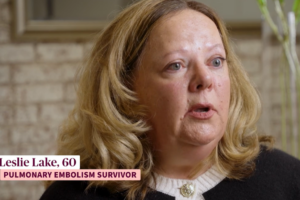DVT and PE Blood Clots
DVT and PE Blood Clots Can Affect Anyone
Blood clots do not discriminate. They can affect anyone regardless of age, ethnicity or race. Up to 900,000 people in the United States are affected by blood clots each year and about 100,000 of those people will die, which is greater than the total number of people who lose their lives each year to AIDS, breast cancer, and motor vehicle crashes combined. Roughly 274 people die each day due to blood clots.
Learn more about blood clots in the United States.
What is a DVT and PE Blood Clot?
A clot that forms in the deep veins, usually in a person’s leg or arm is called deep vein thrombosis or DVT. When a blood clot like this forms, it can partly or completely block the flow of blood or blood circulation in the body. If this clot is not treated, it can move or break off and travel to the lungs. A blood clot in the lung is called a pulmonary embolism or PE, and can be life-threatening and requires immediate medical attention.
Learn more about blood clot risks, signs and symptoms.
Learn more about how a DVT is diagnosed.
Learn more about how a PE is diagnosed.
Learn more about how blood clots are treated.
Know Your Risk
The first and most important thing you can do to protect yourself from a life-threatening blood clot is to learn if you are at risk.
Women in particular face unique blood clot risks connected to choices they make throughout their lives. These choices are connected to estrogen-based birth control and family planning, pregnancy and childbirth and the treatment of menopause symptoms.
Learn more about women and blood clot risks.
Recognize Signs and Symptoms
Symptoms of a blood clot in a person’s leg or arm (deep vein thrombosis or DVT) can include:
- Swelling of the leg or arm
- Pain or tenderness not caused by an injury
- Skin that is warm to the touch
- Redness or discoloration of the skin
Contact your doctor as soon as you can.
Symptoms of a blood clot in a person’s lung (pulmonary embolism or PE) can include:
- Difficulty breathing
- Chest pain that worsens with a deep breath
- Coughing, or coughing up blood
- Faster than normal or irregular heartbeat
Call 911 or seek immediate medical attention.
Learn more about the signs and symptoms of blood clots.
Prevent Blood Clots
Blood clots are dangerous, but they are also preventable. The best ways to prevent blood clots include:
- Know your risk for blood clots.
- Recognize the signs and symptoms of blood clots.
- Tell your doctor if you have risk factors for blood clots.
- Before any surgery, talk with your doctor about blood clots.
- See your doctor as soon as possible if you do have any symptoms of a blood clot. Blood clots can be safely treated.
Learn more ways to prevent blood clots.




